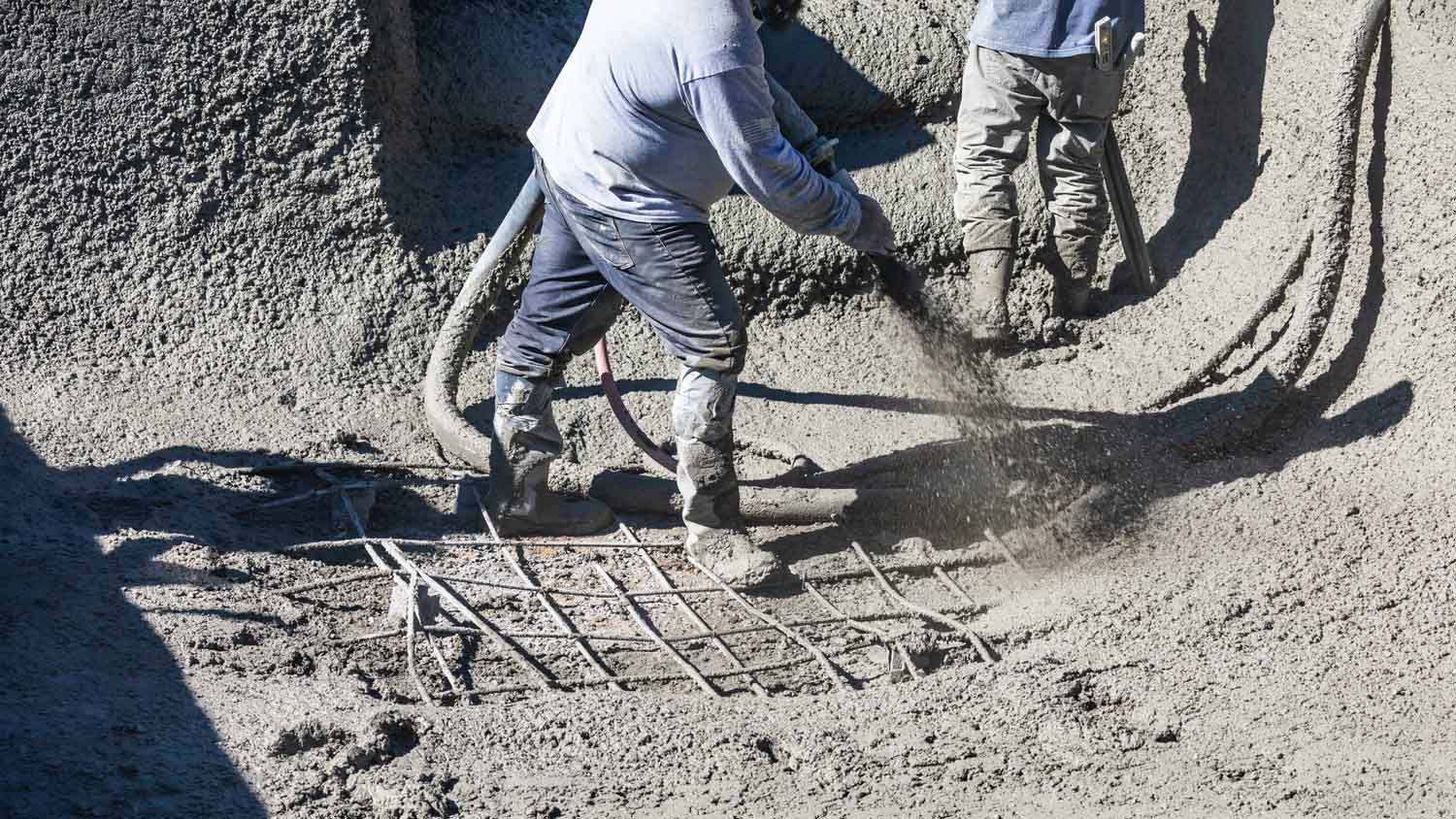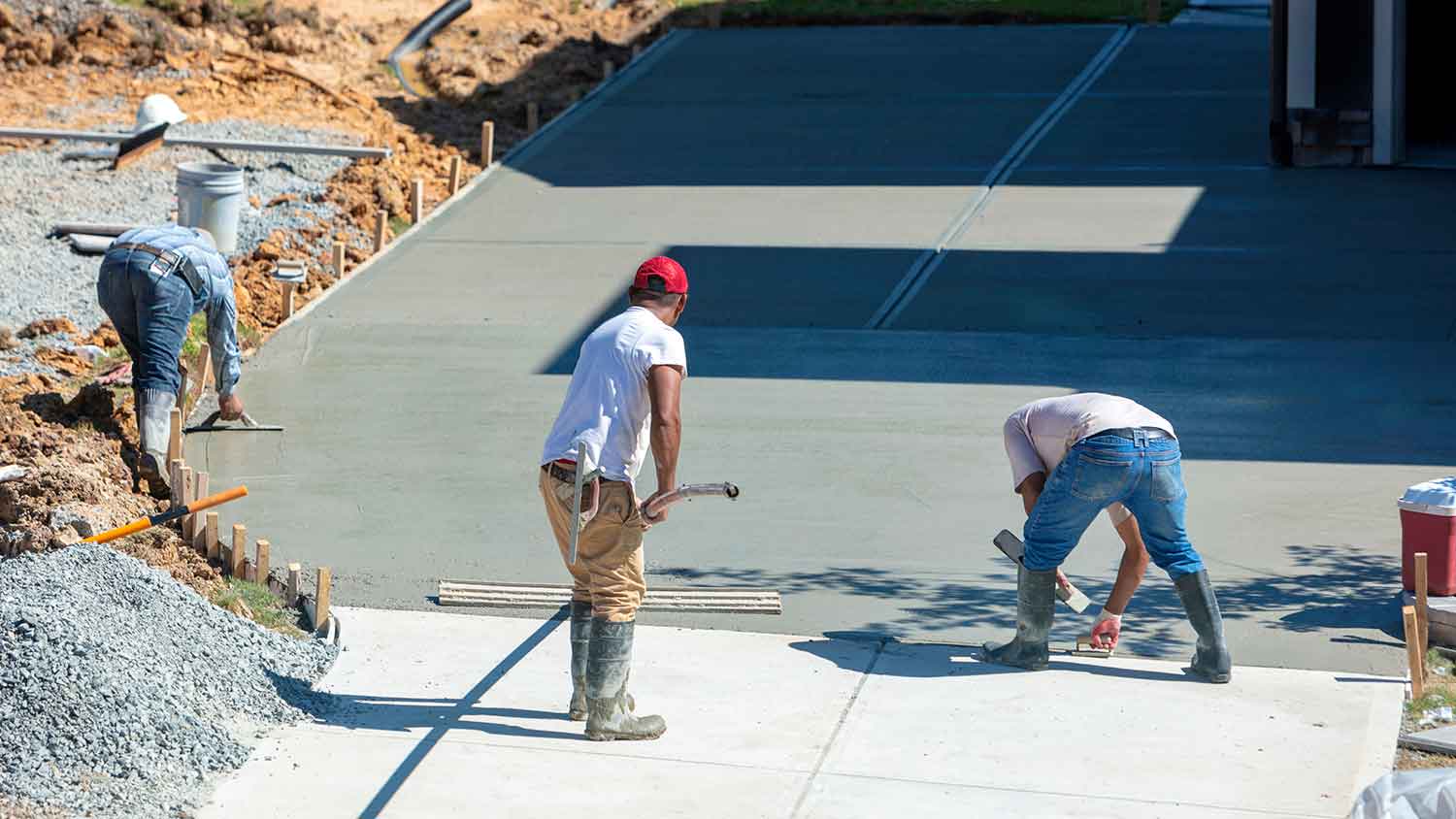
Discover how much concrete walls cost based on factors like their size, material, location, design, and local labor rates.
Shotcrete cost averages $11,000, with most homeowners paying between $4,500 and $18,000. Your price depends on project size, type, location, and material strength.


The average cost of a shotcrete project is $11,000, with most homeowners paying between $4,500 and $18,000 and national costs ranging from $500 to $25,000.
Project size heavily impacts cost, with small repairs costing $500 to $2,000, retaining walls ranging between $3,000 and $12,000, and pools running $8,000 to $25,000.
Wet-mix ranges between $120 and $210 per cubic yard and dry-mix (gunite) runs from $110 to $180.
Labor rates typically run $45 to $85 per hour, with site complexity, accessibility, and preparation influencing total cost.
This article was created using automation technology and thoroughly fact-checked and edited by an Angi Editor in accordance with our AI policy.
Shotcrete cost averages $11,000 for most residential projects, with a range from $500 to $25,000. Homeowners can expect to pay between $110 and $200 per cubic yard, or $6 to $20 per square foot, depending on the project size, location, and type of shotcrete used. Understanding these cost factors helps you budget for your next installation.
Whether you’re building a pool, repairing a foundation, or adding a retaining wall, knowing what drives shotcrete cost ensures you get the best result for your budget. Labor often runs from $45 to $85 per hour, and costs can vary widely by region and project complexity.
The size of your project is one of the most important factors affecting shotcrete cost. The total area or volume—measured in square feet or cubic yards—determines the amount of material and labor needed. For example, a small repair or patch may require just a few cubic yards, while a new pool or large retaining wall can need dozens.
Smaller projects often have higher per-unit costs due to minimum order fees, while larger projects benefit from economies of scale. Thickness also matters. A thicker application means more material and higher costs. Standard projects range from patch repairs and garden walls to large pools and structural foundations.
| Project Type | Average Size (Sq. Ft.) | Average Cost Range |
|---|---|---|
| Pool | 400–1,000 | $8,000–$25,000 |
| Retaining wall | 100–400 | $3,000–$12,000 |
| Foundation | 200–600 | $6,000–$18,000 |
| Small repair | 5–50 | $500–$2,000 |
The type of shotcrete you choose—wet-mix or dry-mix—also impacts your project’s cost. Wet-mix shotcrete is premixed with water before application, providing better consistency and strength for large projects, such as pool installations. Dry-mix shotcrete (also called gunite) mixes with water at the nozzle, making it flexible for repairs and smaller jobs.
Material strength, measured in pounds per square inch (PSI), affects price as higher-strength mixes cost more. Specialty shotcrete, such as fiber-reinforced, colored, or waterproof mixes, adds to the total cost but can provide extra durability or visual appeal. Each type has pros and cons for different applications.
| Shotcrete Type | PSI/Strength | Cost per Cubic Yard | Pros | Cons |
|---|---|---|---|---|
| Wet-mix | 3,000–8,000 | $120–$210 | Consistent quality, less dust | Requires larger equipment |
| Dry-mix (gunite) | 2,500–6,000 | $110–$180 | Flexible for repairs, good for curves | More rebound waste, dustier |
| Fiber-reinforced | 4,000–8,000 | $150–$250 | Added strength, crack resistance | More expensive |
| Colored or decorative | 3,000–6,000 | $150–$250 | Aesthetic options | Fades without maintenance |
| Waterproof | 4,000–8,000 | $160–$260 | Ideal for pools, basements | Higher material cost |
Where you live can significantly impact the cost of shotcrete. Urban areas tend to have higher labor and material costs due to demand, while rural locations may see additional delivery fees. Local contractor availability, market rates, and delivery logistics all play a role.
Indoor projects sometimes cost less than outdoor ones, as weather and site conditions can be easier to manage. Transportation costs for remote sites or challenging access points can also add to your budget.
Several factors influence the final shotcrete cost for your project. Understanding these helps you make informed decisions and plan your budget effectively.
Labor is a major component of shotcrete installation. Projects often require skilled concrete contractors or specialty crews who work with heavy equipment. Labor rates range from $45 to $85 per hour, or $6 to $20 per square foot, depending on region and complexity.
Small projects may be subject to minimum service fees, while large or complex jobs can require bigger crews and longer timelines. Urban locations and difficult site conditions can drive labor costs higher.
Many shotcrete projects, especially pools and retaining walls, require permits. Permit fees vary by location and project type, ranging from $100 to $1,000. Inspections may be required during and after installation, which can add to the total cost. Delays in permitting or inspection can impact your project timeline and budget.
Upgrades and custom features can increase the cost of shotcrete. Decorative finishes—like stamped, colored, or textured shotcrete—cost more than standard gray. Adding embedded lighting, plumbing, or extra rebar reinforcement also raises the price. Waterproofing, drainage systems, and insulation costs are common add-ons for pools and basements.
Other factors can affect your shotcrete cost, including:
Project complexity, such as curves or unique shapes.
Site accessibility for equipment and crews.
Site preparation, like excavation, grading, or debris removal.
Post-construction cleanup and waste disposal.
Design or engineering fees for custom features.
Required inspections and their associated costs.
Beyond installation, several ongoing or one-time expenses can affect your overall investment in shotcrete.
Manufacturer and contractor warranties are often available for shotcrete projects. Standard warranties may cover one to five years, while extended coverage is available for an added fee of $200 to $1,000. Warranties can provide peace of mind and long-term value, especially for major installations.
Routine maintenance extends the life of shotcrete installations. This includes cleaning, sealing, and minor crack repairs. On average, annual maintenance costs run $200 to $800 for most residential shotcrete features. Scheduling professional inspections every few years helps catch problems early and avoid costly repairs.
Hiring a local pro for shotcrete application costs more upfront, but you benefit from proper spraying techniques, structural integrity, and efficient project execution. Pros bring the right equipment—such as shotcrete pumps, hoses, and specialized finishing tools—and the experience needed to apply shotcrete without damaging forms, rebar, or surrounding surfaces.
Pros know how to apply shotcrete efficiently while ensuring proper thickness, adhesion, and coverage, which is critical for structural stability and durability.
They handle the process in accordance with industry standards and local building codes, reducing the risk of weak spots, cracking, or compliance issues.
Hiring a pro reduces the risk of uneven application, rebound waste, or structural deficiencies that could compromise the project or lead to costly repairs.
Many contractors can bundle services such as rebar installation, formwork setup, and surface finishing, helping streamline the entire shotcrete process.
Clear the work area of debris, obstacles, and unnecessary materials to provide easy access for the professional.
Prepare forms or reinforcement as instructed by the pro to help speed up the process.
Handle minor cleanup or prep tasks, such as protecting nearby surfaces, to reduce time spent during the professional shotcrete application.
Knowing when to repair or replace shotcrete is key for cost control. Shotcrete installations often last 30 to 50 years with proper care. Minor cracks, chips, or surface spalling can be repaired for $500 to $3,000. However, severe structural damage or widespread deterioration may require full replacement, costing $4,500 to $15,000 or more.
The 50% rule is a good guideline. If repairs cost more than half the price of replacement, it’s best to replace. Consider the age, warranty status, and extent of damage before making your decision.
Shotcrete projects can boost your home’s value, especially when adding features like a pool or retaining wall. The average return on investment (ROI) for shotcrete installations ranges from 50% to 80%, depending on location and project type.
Compared to other improvements, shotcrete offers strong value due to its durability and low maintenance. Factors that improve ROI include enhanced safety, improved efficiency, functional upgrades, universal design features, and appealing aesthetics. Long-term, shotcrete’s resilience and low upkeep make it a smart investment for many homeowners.
Here are a few ways to keep your shotcrete costs within budget:
Obtain multiple quotes from qualified shotcrete contractors.
Schedule projects during the off-season to take advantage of potential discounts.
Choose standard finishes and avoid unnecessary customizations.
Prepare the site yourself if feasible (e.g., clearing debris, grading).
Purchase materials in bulk for larger projects.
Combine shotcrete work with other home improvements to save on labor.
Maintain shotcrete structures regularly to avoid costly repairs.
Let your pro know the size, shape, and thickness of the area where you want shotcrete applied, so they can plan for the right materials, equipment, and timeline.
Describe any underlying issues you’ve noticed, like cracks, weak substrate, or drainage problems, that could affect the application or require additional preparation.
Ask whether you need to prep the area beforehand, such as clearing debris, installing reinforcement, or ensuring access for the shotcrete equipment.
Confirm whether unexpected costs could arise from issues like difficult access, uneven surfaces, or additional reinforcement needs.
If you’re considering follow-up work—like finishing, sealing, or waterproofing—ask whether it’s more efficient to bundle those services with the shotcrete application.
Home is the most important place on earth, which is why Angi has helped more than 150 million homeowners transform their houses into homes they adore. To help homeowners with their next project, Angi provides readers with the most accurate cost data and upholds strict editorial standards. We extensively research project costs to develop the pricing data you see, so you can make the best decisions for you and your home. We rely on reputable sources, including the U.S. Bureau of Labor Statistics, academic journals, market studies, and interviews with industry experts—all to ensure our prices reflect real-world projects.
Want to help us improve our cost data? Send us a recent project quote to [email protected]. Quotes and personal information will not be shared publicly.
From average costs to expert advice, get all the answers you need to get your job done.

Discover how much concrete walls cost based on factors like their size, material, location, design, and local labor rates.

Discover the average concrete pumping cost, including key price factors and tips to help you budget for your next concrete project.

If your sidewalk is in need of some TLC, this is your comprehensive look at sidewalk replacement cost, so you know what to expect.

Concrete spalling can create hazardous conditions. Learn about the causes of spalling concrete, along with helpful prevention and repair tips.

When your patio, driveway, or walkway needs a new look, can you pour concrete over concrete? Read on to learn when it does—and doesn't—work.

Concrete efflorescence can affect the stability of structures. Learn about concrete efflorescence, including ways to repair it and prevent it from happening in the future.